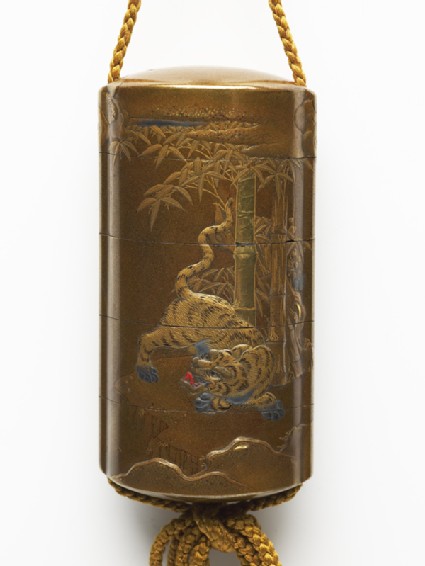Room 37 | Japan 1600-1850 gallery
Discover the arts of the Edo period (1600-1868) from porcelain to lacquer to painting.

Galleries : 175 objects
- Reference URL
Actions
Inrō with animals in a landscape
-
Details
- Associated place
- Date
- 19th century (1801 - 1900)
- Material and technique
- wood, covered in fundame lacquer, and with hiramaki-e, takamaki-e, and kirigane lacquer decoration; silk cord, probably a replacement
- Dimensions
- 9.6 x 4.7 x 3 cm max. (height x width x depth)
- Material index
-
processed material › metal › gold,organic › animal › animal product › silk
- Technique index
- Object type index
- No. of items
- 1
- Credit line
- Presented, 1976.
- Accession no.
- EA1976.40
Glossary (5)
fundame, hiramaki-e, kirigane, lacquer, takamaki-e
-
fundame
Very fine gold powder densely sprinkled onto wet lacquer, giving a smooth, matt surface.
-
hiramaki-e
(‘flat sprinkled design’) coloured or metal powders sprinkled onto a wet lacquer ground and usually covered with a protective layer of lacquer
-
kirigane
(‘cut gold’) metal foil (often gold) cut into various shapes and individually set into a lacquer ground
-
lacquer
Chinese and Japanese lacquer is made from the sap of the lacquer tree, which is indigenous to Eastern China. It is applied to wood as a varnish or for decorative effect. In India and the Middle East, lacquer is made from the deposit of the lac insect.
-
takamaki-e
(high relief sprinkled design’) makie technique in which parts of the design are built up with lacquer mixed with charcoal or clay dust
Location
Objects are sometimes moved to a different location. Our object location data is usually updated on a monthly basis. Contact the Jameel Study Centre if you are planning to visit the museum to see a particular object on display, or would like to arrange an appointment to see an object in our reserve collections.
Galleries
Notice
Objects may have since been removed or replaced from a gallery. Click into an individual object record to confirm whether or not an object is currently on display. Our object location data is usually updated on a monthly basis, so contact the Jameel Study Centre if you are planning to visit the museum to see a particular Eastern Art object.
© 2013 University of Oxford - Ashmolean Museum







